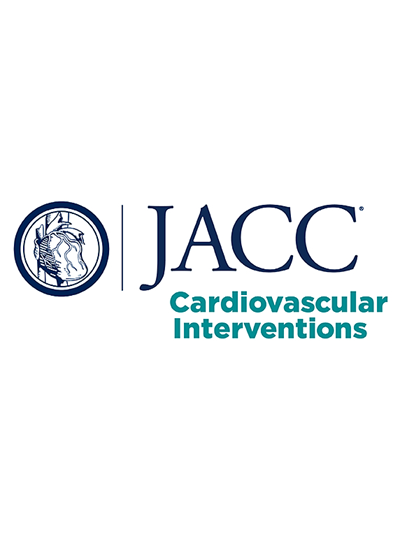Takotsubo综合征微血管功能的预后价值:个体患者资料的汇总分析。
IF 11.7
1区 医学
Q1 CARDIAC & CARDIOVASCULAR SYSTEMS
引用次数: 0
摘要
背景冠状动脉微血管功能障碍似乎在Takotsubo综合征(TTS)的发病机制中起主要作用。然而,在TTS急性期测量微血管功能的预后价值尚不清楚。方法对来自9个前瞻性TTS队列的个体患者数据进行协作、汇总分析,对冠状动脉微血管功能进行有创评估,包括微循环阻力指数(IMR)、冠状动脉血流储备(CFR)和微血管阻力储备(MRR)。主要终点是全因死亡率。次要终点包括主要心脑血管不良事件(MACCE),定义为全因死亡、TTS复发、卒中、短暂性脑缺血发作或心肌梗死的复合。结果本组共纳入166例TTS患者,其中典型(根尖)TTS变异130例(78%),非典型变异36例(22%)。在中位随访20.6[4.3 - 60.0]个月期间,17例(10.2%)患者出现全因死亡,29例(17.5%)患者出现MACCE。IMR、CFR和MRR与全因死亡率相关。调整基线差异后,IMR是两种全因死亡率的唯一独立预测因子(aHR 3.9;95% ci: 1.39 ~ 10.88, p = 0.010;c-statistic 0.817 (95% CI: 0.711-0.923))和MACCE (aHR 2.6;95% ci: 1.17-5.67;P = 0.018;c-statistic 0.719 (95% CI: 0.612-0.826))。结论:在对来自9个前瞻性TTS队列的个体患者数据的汇总分析中,急性期测量的微血管功能障碍与全因死亡率相关。特别是,根据IMR评估,微血管阻力升高是死亡率和MACCE的唯一独立预测因子。本文章由计算机程序翻译,如有差异,请以英文原文为准。
Prognostic Value of Microvascular Function in Takotsubo Syndrome
Background
Coronary microvascular dysfunction appears to play a major role in the pathogenesis of Takotsubo syndrome (TTS). However, the prognostic value of microvascular function measured in the acute phase of TTS is unclear.
Objectives
This study sought to assess the prognostic value of microvascular function measured invasively in the acute phase of TTS.
Methods
In a collaborative, pooled analysis of individual patient data from 9 prospective TTS cohorts, invasive assessment of coronary microvascular function was performed, including the index of microcirculatory resistance (IMR), coronary flow reserve, and microvascular resistance reserve. The primary endpoint was all-cause mortality. Secondary endpoints included major adverse cardiac and cerebrovascular events (MACCE) defined as the composite of all-cause death, recurrence of TTS, stroke, transient ischemic attack, or myocardial infarction.
Results
A total of 166 patients with TTS were included, in whom 130 (78%) had the typical (apical) TTS variant and 36 (22%) had an atypical variant. During a median follow-up of 20.6 [4.3-60.0] months, all-cause mortality occurred in 17 patients (10.2%) and MACCE in 29 patients (17.5%). IMR, coronary flow reserve, and microvascular resistance reserve were associated with all-cause mortality. After adjustment for baseline differences, IMR was the only independent predictor of both all-cause mortality (aHR: 3.9; 95% CI: 1.39-10.88; P = 0.010; c-statistic 0.817; 95% CI: 0.711-0.923) and MACCE (aHR: 2.6; 95% CI: 1.17-5.67; P = 0.018; c-statistic 0.719; 95% CI: 0.612-0.826).
Conclusions
In this pooled analysis of individual patient data from 9 prospective TTS cohorts, microvascular dysfunction measured in the acute phase was associated with all-cause mortality. In particular, an elevated microvascular resistance, as assessed by IMR, was the only independent predictor of both mortality and MACCE.
求助全文
通过发布文献求助,成功后即可免费获取论文全文。
去求助
来源期刊

JACC. Cardiovascular interventions
CARDIAC & CARDIOVASCULAR SYSTEMS-
CiteScore
11.60
自引率
8.80%
发文量
756
审稿时长
4-8 weeks
期刊介绍:
JACC: Cardiovascular Interventions is a specialist journal launched by the Journal of the American College of Cardiology (JACC). It covers the entire field of interventional cardiovascular medicine, including cardiac, peripheral, and cerebrovascular interventions. The journal publishes studies that will impact the practice of interventional cardiovascular medicine, including clinical trials, experimental studies, and in-depth discussions by respected experts. To enhance visual understanding, the journal is published both in print and electronically, utilizing the latest technologies.
 求助内容:
求助内容: 应助结果提醒方式:
应助结果提醒方式:


